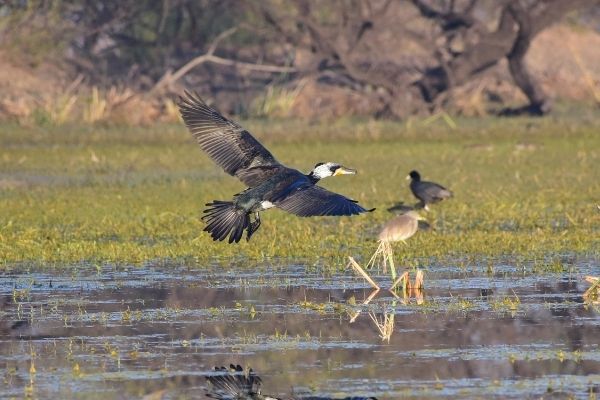Bharatpur’s foundation was laid in the 18th century when Maharaja Suraj Mal captured the city by defeating the vanquishing Khemkaran. The city’s diverse flora and fauna are now a haven for nature lovers and wildlife enthusiasts. There are also numerous forts and palaces throughout the city that attract visitors from all over the world. In addition, the location is regarded as one of the best birdwatching destinations in the world. To assist you in planning your trip, we have highlighted the most exciting things to do in Bharatpur that should be on your itinerary.
7 Best Places To Visit In Bharatpur In 2022
Keoladeo Ghana National Park


The Keoladeo Ghana National Park, formerly known as the Bharatpur Bird Sanctuary, is one of the best birdwatching destinations in the world. This artificial wetland now covers an area of 29 square kilometres. The swamp is well-known for the migratory birds that flock here, including ducks, geese, waders, raptors, flycatchers, and many others. In addition, birders and ornithologists flock to the area to study the birds during the winter.
This location has a total of 370 species recorded. The Siberian Crane can also be found here. This is also an important World Heritage Site and breeding ground. For those looking for adventure, there is also a well-defined trek route. These trek routes can be covered on foot, by bike, or by rickshaws pulled by trained rickshaw pullers who are highly knowledgeable about the area.
Bharatpur Palace & Museum


This is essentially a museum. One of the best things to do in Bharatpur is to go here. In Kamra Khas, the museum is housed within the palace. There are numerous antiques in the room. Over 581 stone sculptures, 861 local art and craft articles, and ancient scriptures are among them. These scriptures depict the art and culture that are unique to Bharatpur. The palace is a work of art that combines Mughal and Rajput architecture.
This is because the entire palace was built in stages by various Maharajas. The variety of richly patterned floor tiles decorated with exquisite designs is one of the palace’s most exciting features. Everything about this palace is opulent. This location is a Bharatpur-specific Indian culture, history, and traditions repository.
Lohagarh Fort


The Lohagarh Fort has withstood numerous battles, living up to its name. The majority of these were British attacks. The Lohagarh fort is not a striking structure that flaunts its architectural splendour; instead, it exudes a rugged strength. Numerous monuments include the Kothi Khas, Mahal Khas, Moti Mahal, Kamra Mahal, and Kishori Mahal. Lohagarh Fort is regarded as one of the most powerful forts in Indian history.This fort has two gates: the Ashtdhaatu (eight-metalled) to the north and the Chowburja (four-pillared) to the south. The Kamra Mahal is now the State Archaeological Museum, and visiting it is one of the most popular things to do in Bharatpur. In the armoury section, you can see old portraits of the Maharajas who ruled here, as well as various types of guns and miniature cannons.
Laxman Mandir


This Hindu shrine is dedicated to Lord Rama’s brother, Lakshman. This should be at the top of your list of things to do in Bharatpur. It would help if you came here to see the intricate carvings of flowers and birds on the Temple’s doorways, ceilings, pillars, walls, and arches. The Temple houses our country’s invaluable culture and history.
Banke Bihari Temple


The idols in this Temple are all made of Ashtadhatu (a unique combination of eight metals). This Temple is over 400 years old and is one of Bharatpur’s most prominent temples. The Temple is said to have been built by a Naga Saint who worked to better humanity. Every year, a large number of devotees visit the Temple. The Temple is beautifully designed in the Rajasthani style.
This lovely garden town is part of a fort located north of Bharatpur. One of the most important things to do in Bharatpur, Rajasthan, is to visit this location. There is a watchtower here from which the entire city can be seen. The city’s interior is in ruins, but this tower remains one of the best attractions. Every year in September, there is a three-day festival that draws many tourists from worldwide.When you come to see the garden, don’t forget to visit the Jal Mahal, which adds to the beauty of the place with its beautiful architecture. The park is surrounded by beautiful palaces such as the Gopal Bhavan, Suraj Bhavan, Nand Bhavan, Kishan Bhavan, Keshav Bhavan, Purana Mahal, and Sheesh Mahal.
Bharatpur Bird Sanctuary


After the Keoladeo National Park, this old forest reserve is another bird watcher’s paradise. Over 200 species are found here, including the elusive Black Bittern. The place built by maharajaRam Singh in the year royal family of Bharatpur still owes 1897 AD. Maharaja Jaswant Singh built the dam on the Kakund River in 1866 AD. This area has been under British control for a very long time. The Kakund River dam is a popular picnic spot in this area. In the winter, it attracts a large number of tourists.
Band Baretha Bird Sanctuary


Band Baretha is scattered across a vast landscape, which is why animals roam, plays, and hunting openly is an exhilarating and unique experience. As a result, every guest should go on a Jeep Safari while they are here. A vehicle safari is the finest way to see big cats, while a gentle float down the Kabini River in a coracle—a tiny round boat—provides excellent viewing possibilities for aquatic birds, crocodiles, and Indian elephants. The best time to visit the Band Baretha Wildlife Sanctuary is between February and November. The sanctuary is open from 6 a.m. to 10 p.m.The voice of birds and the landscape is something that makes us close to nature. It’s a slice of authentic India, away from the obsessed selfie culture. Originally a duck hunting ground for maharajas in the nineteenth century, it was designated as a bird sanctuary in 1976 and a national park in 1982. That’s why it is recognised as UNESCO’S World Heritage.



